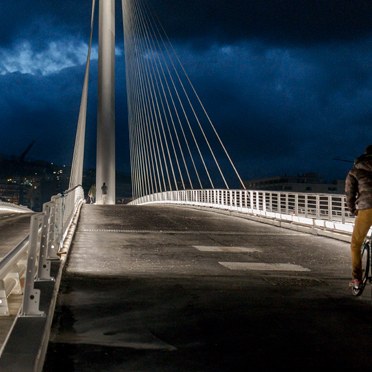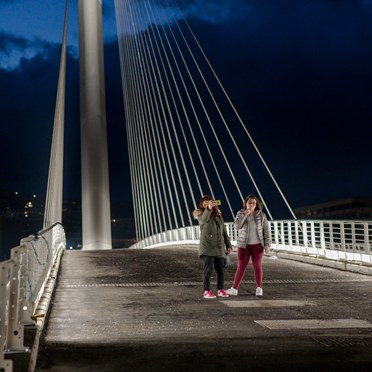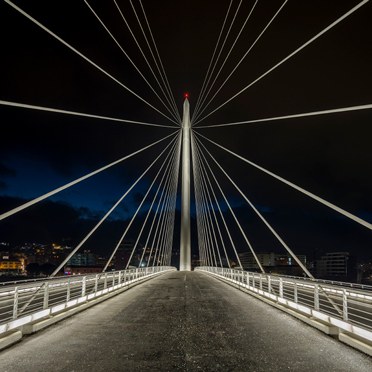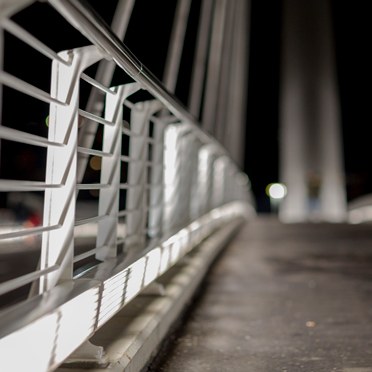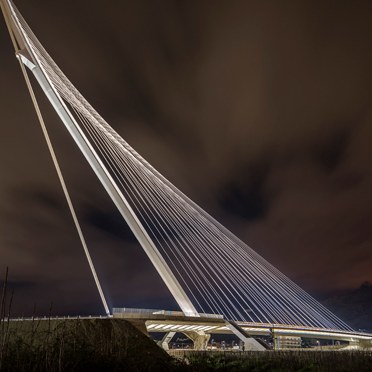Light makes Cosenza’s new bridge a true landmark
- Lamp efficacy
Lamp efficacy
Ensuring the lamp efficiently converts electricity into light (lm/W).
- Ballast classification
Ballast classification
Controlling the electricity supply to the lamp (Energy Efficiency Index).
- Luminaire distribution
Luminaire distribution
Controlling light emission using optics which bend and shape the light to the correct location.
- System efficacy
System efficacy
Combining optical and thermal control within the luminaire (luminaire lm/W).
- Presence/absence detection
Presence/absence detection
Providing lighting only when it’s needed.
- Daylight detection
Daylight detection
Reducing waste light during daylight hours.
- Constant illuminance
Constant illuminance
Producing the correct lighting levels for the duration of the maintenance period.
- Task-scene setting
Task-scene setting
Allowing the user to set scenes and adapt the lighting to different tasks.
- Timed off
Timed off
Automatic cut-off to turn all lights off during unoccupied hours.
- Task lighting
Task lighting
Lighting task areas with the correct amount of light.
- Zoning of lighting
Zoning of lighting
Zoning lighting in accordance to occupancy patterns or window location.
- Maintenance schedule
Maintenance schedule
Tailoring maintenance schedules in accordance to product age, performance and environment.
- Waste light
Waste light
Eliminating waste light which does not hit the intended target.
- Reflectance
Reflectance
Taking advantage of light which is reflected from the surface within the space.
- Visible smart metering
Visible smart metering
Enabling results of actions to be quickly seen as increased or decreased energy use to encourage responsible energy consumption.
Lighting from Thorn and Zumtobel has helped create a unique and iconic structure for this Italian city
Challenge
In January 2018 a stunning new road and pedestrian bridge opened in the southern Italian city of Cosenza. Designed by renowned Spanish architect Santiago Calatrava, the San Francesco di Paola bridge is one of the most significant infrastructure projects in the region in recent years. Calatrava’s vision was to create a “harp-shaped” bridge. Suspended from a 104-metre-high “antenna”, rising at an angle of 52 degrees, the cables that support the bridge are reminiscent of the strings of a harp.
The bridge’s lighting had two objectives: to enhance the view of the great “antenna” from a distance, and from a functional point of view, to provide clear and comfortable illumination for vehicles and pedestrians.
Solution
The lighting system consists of forty large 88W Contrast LED spotlights from Thorn, mounted on the bridge’s 40 tie rods. Each spotlight has a narrow 8° beam angle and a colour temperature of 4000K, chosen to complement the structure’s white body.
Equipped with refractors and anti-glare visors, the Contrast LED spots provide a uniform glow along the antenna, ensuring maximum visual comfort for pedestrians on the bridge’s walkway, which runs in the middle, between the lanes of traffic. All the spotlights are RGB and can be controlled using a DMX controller, to create dynamic light shows for special events. They can even be synchronised with music to make the whole bridge mimic a giant harp.
The design also includes side lighting along both the traffic and pedestrian lanes, with Tubilux LED fittings from Zumtobel installed into the lower part of the railings to create a “carpet of light”. The cables for the Tubilux fittings are simple and extremely slim, with a mechanical anchoring system for easy insertion into the structure of the bridge, saving time and money during installation.
Result
The new bridge shows how light can transform structures into true landmarks. The bridge’s majestic antenna is now an iconic feature for the city of Cosenza.
By using LED lighting, the bridge uses 60% less energy that it would have if an alternative metal halide and fluorescent design had been used, with an installed load of just 37kW.

